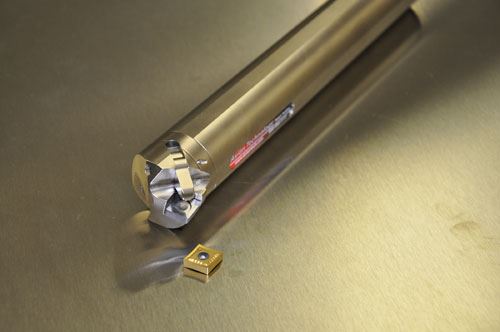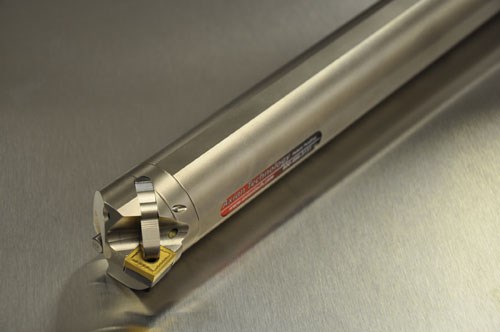Lathe Toolholder Allows Quick Insert Changes
This lathe toolholder allows insert changes in a matter of seconds with the push of a button. Its cam-actuated lever provides a uniform insert clamping pressure of 8,000 psi.
Most cutting tool inserts secure to a toolholder via an allen screw. In order to change or index an insert, an operator grabs an allen wrench, removes the screw and insert, and then carefully aligns and reinstalls the insert. It’s possible that an inexperienced operator might improperly install or misalign the insert, which could lead to scrap or re-work. Over time, the screws and/or the toolholder’s mating threads can become worn or stripped, too. And it’s not uncommon for operators to lose or misplace toolholder wrenches and screws.
There is a toolholding alternative for lathes that can help shops avoid these issues and reduce insert changeover time. The Click-Change toolholder from Axian Technology (Phoenix, Arizona) requires no wrenches or screws and ensures that the insert is properly located in the toolholder. The company says insert changes can be performed in seconds, saving shops as much as two minutes per insert change.
The Click-Change toolholder uses a cam-actuated lever that provides a uniform insert clamping pressure of 8,000 psi. When an operator pushes the release button at the end of the toolholder, the cam unlocks and releases the clamp to allow the insert to be removed. The operator then positions the fresh insert into the toolholder’s locating pocket and pushes down on the lever to lock it into place.
The toolholder’s locking mechanism does not rely on spring pressure to secure the insert. Instead, an internal drive spring engages a high-angle locking wedge that performs the clamping action. Once engaged, the wedge cannot be loosened by any amount of machining force.
Click-Change versions are currently offered for CNMG, VNMG, WNMG and DNMG insert geometries. The toolholders are available in square shank sizes ranging from 0.75 to 1.25 inches in both left- and right-hand models (metric sizes are also available). The company also offers boring bar and Coromant Capto versions. All models have internal coolant ports.
During insert changes, the company recommends that operators blow all chips and coolant away from the insert and the surrounding area before releasing and removing the worn insert. Users should also blow off the open toolholder pocket before installing the new insert.
Related Content
-
Finding the Right Tools for a Turning Shop
Xcelicut is a startup shop that has grown thanks to the right machines, cutting tools, grants and other resources.
-
Norton | Saint Gobain Abrasives' Wheels Increase Metal Removal
The Norton Winter Paradigm Plus Diamond and Winter G-Force Plus Next Generation Diamond Wheels expand the company’s grinding wheel options.
-
Sumitomo's Grooving Inserts Bypass Interference
Eastec 2023: The 90-degree inserts are said to be ideal for grooving narrow parts and facing in OD and ID applications that require unique approaches due to interference.













.jpg;maxWidth=300;quality=90)




